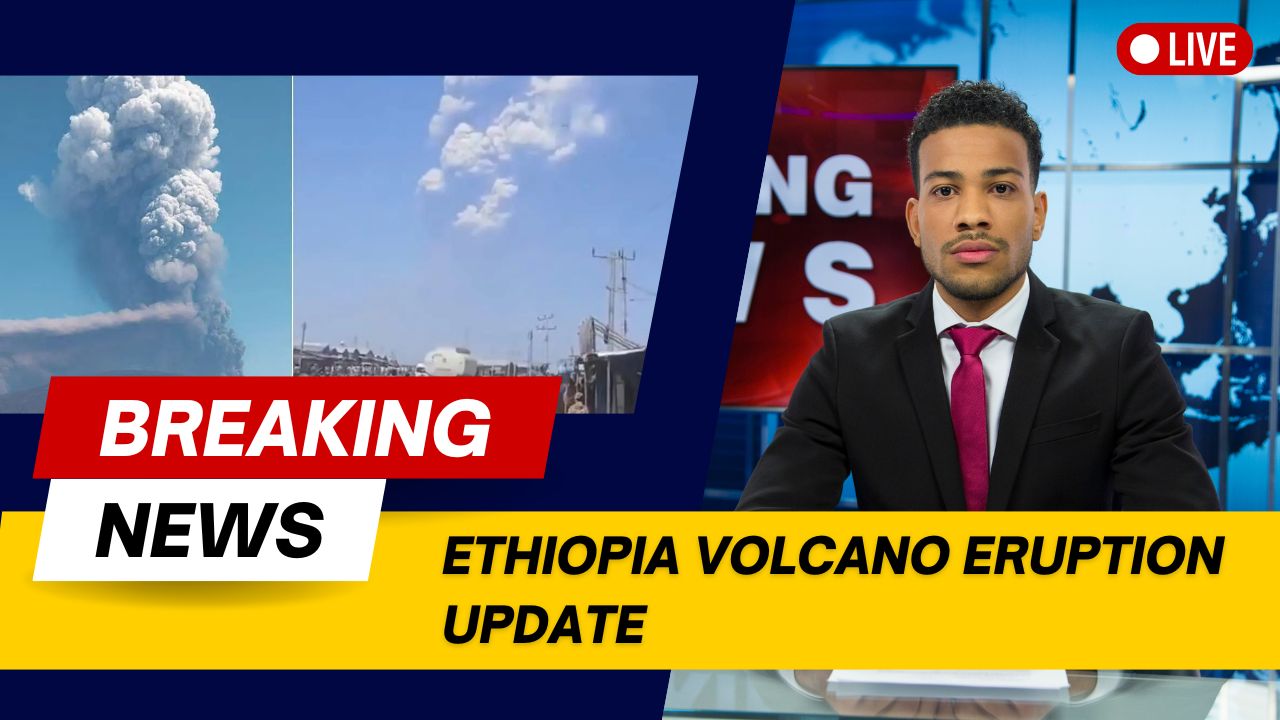If you’ve been following the news, you’ve probably seen the phrase Ethiopia volcano eruption dominating timelines—and for good reason. A long-dormant volcano in northern Ethiopia, the Hayli Gubbi volcano, erupted for the first time in almost 12,000 years, sending enormous ash plumes across the Red Sea and creating an unexpected chain of disruptions across multiple countries, including India.
Within hours, the ash cloud drifted over the Arabian Sea, entered Gujarat late Tuesday night, and spread toward Rajasthan, Delhi-NCR, Haryana, Punjab, and northwest Maharashtra. The result? Major flight cancellations, rerouting of international air traffic, and heightened monitoring from meteorological agencies.
In this comprehensive guide, you’ll find live updates, expert insights, flight cancellation lists, ash cloud movement patterns, and a clear breakdown of what the Ethiopia volcano eruption means for travelers, residents, and the aviation industry.
Let’s unpack everything—step by step.
What Triggered the Ethiopia Volcano Eruption?
The Hayli Gubbi volcano, located in Ethiopia’s Afar region, stunned scientists when it erupted suddenly on Sunday. As a volcano dormant for thousands of years, its reactivation was both unexpected and powerful.
Key facts about the eruption
- First eruption in nearly 12,000 years
- Ash plume rose rapidly over northern Ethiopia
- Winds carried the ash across the Red Sea, impacting Yemen and Oman
- Over the next 24 hours, it traveled across the Arabian Peninsula and entered the Indian subcontinent
Meteorologists described the ash plume as fast-moving, reaching speeds of 100–120 km/h, and reported that it has been traveling at altitudes of 15,000–25,000 feet, occasionally even rising to 45,000 feet.
How Did the Ash Cloud Travel from Ethiopia to India?
This has been one of the most frequently asked questions. How does ash from the Ethiopia volcano eruption end up thousands of kilometers away?
The movement pathway of the ash cloud
- Nov 23, 7 PM: Eruption begins; ash rises over northern Ethiopia
- Overnight: Strong westerly winds push the plume across the Red Sea
- By Nov 24, 5 AM: Ash reaches the Arabian Peninsula
- Later that night: Cloud enters Indian airspace, first sighted over Gujarat
- Nov 24–25: Reaches Rajasthan, Delhi, Haryana, Punjab, and Maharashtra
- Nov 25 evening: Expected to drift toward China
Meteorological agencies like IndiaMetSky Weather and IMD have been tracking the plume through satellites and atmospheric models.
What the ash cloud contains
- Volcanic ash
- Sulphur dioxide
- Glass and rock particles
- Fine aerosols
This unique combination is why it can travel long distances and still influence aviation at high altitudes.
Impact of the Ethiopia Volcano Eruption on India
- Flight cancellations and aviation disruptions
The aviation sector faced the most immediate impact. Because volcanic ash can severely damage aircraft engines, the DGCA (Directorate General of Civil Aviation) issued a strict advisory asking airlines to avoid all ash-affected zones and altitudes.
Airlines that cancelled or rerouted flights
- Air India
- IndiGo
- Akasa Air
- KLM
- Other international carriers passing through the Muscat FIR (Flight Information Region)
Air India alone cancelled 11 flights, including:
- New York–Delhi
- Newark–Delhi
- Doha–Mumbai
- Dubai–Hyderabad
- Mumbai–Hyderabad–Mumbai
- Mumbai–Kolkata–Mumbai
…and more.
Akasa Air cancelled all flights to and from Jeddah, Abu Dhabi, and Kuwait for Nov 24–25.
IndiGo cancelled six flights and rerouted others.
Even Kochi International Airport reported cancellations of Dubai- and Jeddah-bound flights.
- Rerouting through Pakistan airspace
International carriers began using Pakistani airspace for certain routes. However, Indian carriers cannot use Pakistan airspace, causing additional complications and delays.
- Visibility changes
The ash plume caused darker skies, mild haziness, and reduced visibility across large parts of North India.
- Temperature rise
According to IMD, the ash cloud behaves like regular cloud cover—trapping heat and causing a rise in minimum temperature.
Will the Ethiopia Volcano Eruption Affect Air Quality?
This is a major concern for people in Delhi-NCR and other affected regions.
What experts say
- The ash cloud is at high altitudes, so AQI impact on Indian cities is minimal.
- However, sulphur dioxide levels may rise in:
- The Himalayan region
- Nepal’s hill belt
- Terai region of Uttar Pradesh
The reason? Sulphur dioxide can disperse widely and react with atmospheric particles.
Is ashfall expected in India?
- Low chance, according to IndiaMetSky Weather
- The ash concentration is relatively low
- The plume is moving fast and staying high in the atmosphere
Residents in northern India are unlikely to experience ashfall on the ground.
Latest Live Updates on the Ethiopia Volcano Eruption
Here is a simplified, summarized timeline based on the detailed updates you provided:
Nov 25, 2025 Morning
- Air India cancels 11 flights, offers hotels and alternative arrangements
- Akasa Air cancels all Jeddah/Kuwait/Abu Dhabi flights for two days
- IMD predicts ash cloud will leave India by 7:30 PM
- Indigo, Akasa Air, and KLM confirm cancellations and rerouting
Early Morning – Overnight
- DGCA issues safety advisory
- Ash cloud continues drifting over Delhi, Haryana, Rajasthan
- Minimal AQI impact expected
- Rerouting through Pakistan airspace causes strain on Indian carriers
Late Night – Previous Day
- Ash cloud enters Gujarat
- Two flights from Kochi cancelled
- IMD confirms possible temperature rise
- Visuals at Delhi airport show delays but operations continue with caution
Why Volcanic Ash Is Dangerous for Aircraft
Understanding this helps explain why the aviation sector responds so quickly.
Volcanic ash can:
- Melt inside aircraft engines
- Damage turbine blades
- Block sensors
- Scratch cockpit windows
- Reduce visibility
- Cause engine flameouts
This is why DGCA instructs airlines to:
- Avoid ash zones completely
- Report any suspected ash encounters
- Increase fuel planning for alternate routes
- Inspect runways for ash contamination
What Happens Next?
Based on IMD’s models, the next steps are clear:
Where the ash plume is heading
- Moving east toward China
- Expected to exit Indian airspace by 7:30 PM (IST) today
- Will continue diffusing as it travels further across Asia
What authorities are doing
- Continuous satellite monitoring
- Updating flight advisories
- Issuing ASHTAM alerts (volcanic ash notices to pilots)
- Coordinating with international meteorological services
What travelers should do
- Check flight status frequently
- Expect potential delays
- Keep travel documents and apps handy
- Follow airline advisories for rebooking or refunds
Frequently Asked Questions About the Ethiopia Volcano Eruption
- Is the Ethiopia volcano still erupting?
No. The initial eruption has stopped, but the ash plume remains active in the atmosphere.
- Will the ash cloud affect health?
Not significantly for people in India, as it’s high in the atmosphere.
- Will flights resume soon?
Most airlines expect normalization once the ash cloud leaves Indian airspace.
- How often do such long-dormant volcanoes erupt?
Rarely—but geological models indicate that dormant volcanoes can awaken due to tectonic shifts.
Conclusion: Stay Prepared, Stay Updated
The Ethiopia volcano eruption has created a ripple effect across continents—impacting aviation, weather conditions, and visibility. While the situation is evolving, meteorological agencies and aviation authorities are working around the clock to ensure safety.
If you’re traveling, stay alert to updates from airlines. If you’re simply following global events, this eruption is a powerful reminder of how interconnected our world is—where a volcanic event in Ethiopia can influence skies over India within hours.





